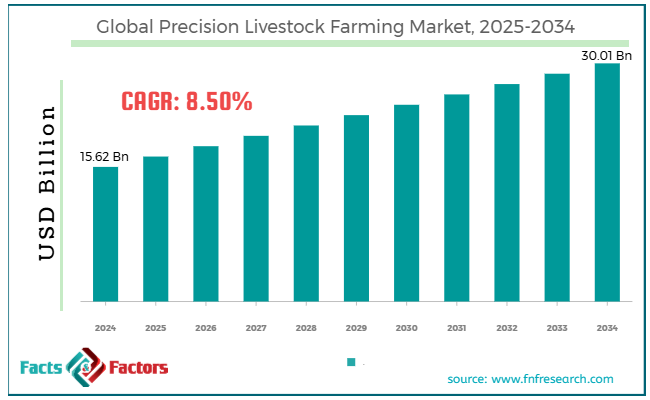Search Market Research Report
Precision Livestock Farming Market Size, Share Global Analysis Report, 2025 - 2034

Precision Livestock Farming Market Size, Share, Growth Analysis Report By Offering (Hardware, Software, Services), By Technology (Milking Robots, Precision Feeding Systems, Identification and Tracking), By Application (Milk Harvesting, Feeding Management), And By Region - Global Industry Insights, Overview, Comprehensive Analysis, Trends, Statistical Research, Market Intelligence, Historical Data and Forecast 2025 - 2034
Industry Insights
[221+ Pages Report] According to Facts & Factors, the global precision livestock farming market size was worth around USD 15.62 billion in 2024 and is predicted to grow to around USD 30.01 billion by 2034, with a compound annual growth rate (CAGR) of roughly 8.50% between 2025 and 2034.

 Market Overview
Market Overview
Precision livestock farming is an innovative practice that uses modernized technologies like data analytics, sensors, and automation to track and manage livestock productivity, health, and welfare in real-time. It allows farmers to make data-based decisions that enhance efficiency, improve animal welfare, and lessen environmental impact. The key propellers of the worldwide precision livestock farming market include growing consumer demand for sustainable and ethical products, technological improvements, and supportive government incentives. Consumers are actively preferring ethically produced and traceable livestock items. Precision livestock farming solutions support transparency in animal welfare practices, allowing farmers to meet regulatory policies and consumer expectations.
Incorporating artificial intelligence, IoT, and robotics has transformed livestock management. Tools like automated milking systems and wearable devices allow real-time animal behavior, health, and productivity tracking. It helps to make wiser decisions and enhance operational efficiency. Moreover, governments on a global scale are offering subsidies and initiatives to enhance farming practices, promise food security, and improve productivity.
Nevertheless, the global market is constrained by significant initial investments and a lack of technical skills. The upfront costs of installing PLF systems, such as purchasing software, sensors, and infrastructure, could be restrictive for small and medium-sized businesses. Furthermore, the successful adoption and operation of precision livestock farming systems require expert skills and knowledge. The lack of professionals may hamper the adoption and efficient use of these solutions.
Yet, the global precision livestock farming industry is well-positioned to develop affordable solutions, advance emerging technologies, and expand into developing markets. There is an increasing opportunity to create scalable, cost-efficient precision livestock farming technologies modified for SMEs, allowing widespread adoption in diverse farm sizes.
Also, incorporating ML and AI into PLF algorithms may significantly improve predictive analytics, allowing farmers to predict health problems, enhance feeding timetables, and boost overall farm management. Besides, the developing markets, mainly in Africa and the Asia Pacific, offer key opportunities for adopting PLF due to the ever-increasing demand for food, the need for improved farming practices, and urbanization.
 Key Insights:
Key Insights:
- As per the analysis shared by our research analyst, the global precision livestock farming market is estimated to grow annually at a CAGR of around 8.50% over the forecast period (2025-2034)
- In terms of revenue, the global precision livestock farming market size was valued at around USD 15.62 billion in 2024 and is projected to reach USD 30.01 billion by 2034.
- The precision livestock farming market is projected to grow significantly owing to the rising demand for sustainable farming practices, increasing incorporation of AI, machine learning, and IoT, and the benefit of resource efficiency.
- Based on the offering, the hardware segment is expected to lead the market, while the services segment is expected to grow considerably.
- Based on technology, the milking robots segment is the dominating segment, while the precision feeding systems segment is projected to witness sizeable revenue over the forecast period.
- Based on the application, the milk harvesting segment is expected to lead the market compared to the feeding management segment.
- Based on region, North America is projected to dominate the global market during the estimated period, followed by the Asia Pacific.
 Growth Drivers
Growth Drivers
- Assimilating blockchain for transparency and traceability drives market growth
Blockchain technology is studied to enhance transparency and traceability in the global livestock supply chain. This promises the quality and authenticity of animal products. By observing every movement and transaction of livestock on an immutable, secure ledger, blockchain meets regulatory needs for food quality and safety and strengthens consumer trust. This incorporation not only enhances efficiency in the supply chain but also offers consumers certifiable details regarding the quality and origin of their food, eventually driving the growth of the precision livestock farming market.
- Will progress in real-time monitoring and sensor technologies considerably fuel the precision livestock farming market growth?
Developing reliable, cost-effective sensors has supported the adoption of precision livestock farming systems. These sensors track different parameters like feed intake, body temperature, and activity levels, offering real-time information for farmers. For example, wearable devices on animals, especially cows, detect signs of illnesses like avian influenza strains D1.1 and H5N1, reducing the spread of infections and allowing early intervention. Incorporating data analytics platforms with these sensors enables proactive management of livestock productivity and health.
 Restraints
Restraints
- Low internet connectivity in rural zones negatively hinders market progress
Precision livestock farming solutions depend on a stable internet connection for cloud-based analytics and real-time transmission. Nonetheless, most rural areas suffer from poor network infrastructure, especially in developing nations. A GSMA 2016 report underscored that in 69 economies among 750 million growers, roughly 295 million owned a mobile phone, but only 13 million owned a cellphone with a mobile money account. This digital divide hinders the efficient deployment and use of precision livestock farming systems, limiting their effectiveness and reach.
 Opportunities
Opportunities
- How does robotic automation of exhaustive farm processes positively impact the precision livestock farming market growth?
Robotics in livestock farming is addressing labor scarcity and enhancing operational efficacy. Automated milking systems can capably milk cows with reduced human intervention, enabling them to drink milk whenever required. Robotic feeding systems set feed intake quantity depending on metabolic needs and real-time intake. Automated scrapers also clean animal housing automatically, reducing infection risks and enhancing hygiene. This is one of the key opportunities in the precision livestock farming industry. Farms utilizing automated milkers report reduced labor costs by 30-50% and production progress by nearly 15%. A leading feeding robot, DeLavel’s Optimat, gained significant prominence in 2023 after case studies presented a roughly 25% rise in feed efficacy.
 Challenges
Challenges
- Do data security, privacy, and ownership concerns limit the growth of the precision livestock farming market?
The widespread data-collection characteristics in PLF systems increase data privacy and security concerns. Farmers are worried about illegal access to confidential information like operational practices and livestock health status. These breaches may result in data misuse or competitive drawbacks. Also, the lack of standardized rules in regions worsens these issues, as inconsistent information protection laws may expose farmers to possible violations.
 Report Scope
Report Scope
Report Attribute |
Details |
Market Size in 2024 |
USD 15.62 Billion |
Projected Market Size in 2034 |
USD 30.01 Billion |
CAGR Growth Rate |
8.50% CAGR |
Base Year |
2024 |
Forecast Years |
2025-2034 |
Key Market Players |
Merck Animal Health, Connecterra, Vencomatic Group, Cainthus, Animals.ai, Farmsee, OneCup AI, Beakbook, Farm4Trade, OPTIfarm, Distynct, Alpha Phenomics, FarmWise, SwagBot, SkyKelpie, and others. |
Key Segment |
By Offering, By Technology, By Application, and Region |
Major Regions Covered |
North America, Europe, Asia Pacific, Latin America, and the Middle East &, Africa |
Purchase Options |
Request customized purchase options to meet your research needs. Explore purchase options |
 Segmentation Analysis
Segmentation Analysis
The global precision livestock farming market is segmented based on offering, technology, application, and region.
Based on offering, the global precision livestock farming industry is divided into hardware, software, and services. The hardware segment has registered the highest market share in recent years and is expected to maintain its leadership. The segment entails wearable tracking devices, sensors, robotic systems, cameras, and RFID tags. These devices are paramount for real-time tracking and monitoring of livestock behavior, productivity, and health. The rising adoption of IoT-based automation and devices has majorly contributed to the prominence of the segment. Hardware devices gather vital data that offer crucial insights into diverse aspects of farm animal management, resulting in enhanced farm productivity and efficiency.
Based on technology, the global precision livestock farming industry is segmented into milking robots, precision feeding systems, and identification and tracking. The milking robots segment will hold a larger market share over the coming years. They are the first innovations in PLF, majorly revolutionizing dairy production globally. These systems automate the milking procedure, enabling cows to be milked as they need. This can be elongated to 24 hours instead of pre-set intervals. This flexibility significantly enhances milk production and quality. The adoption of milking robots has been mainly declared in regions like North America and Europe, fueled by the growing labor costs and increasing need for efficiency in larger dairy operations.
Based on the application, the global market is segmented into milk harvesting and feeding management. The milk harvesting segment is expected to lead the international market due to the rising adoption of automated milking systems like robots. These systems offer enhanced milk efficiency, reduced labor charges, and better milk quality. The increasing demand for dairy products and the growing need for efficient milk production processes have driven the adoption of these technologies.
 Regional Analysis
Regional Analysis
- Will North America witness significant growth in the precision livestock farming market over the forecast period?
North America is projected to lead the global precision livestock farming market over the coming years owing to technological infrastructure, government support and initiatives, cost pressures, and labor scarcity. The region brags about its sophisticated infrastructure for cloud computing, internet connectivity, and data analytics. This strong base is vital for using and earning the advantages of PLF solutions.
Also, government initiatives like subsidies and grants promote the rise of PLF solutions in North America, boosting the region's prominence as a leader. Furthermore, increasing labor charges and scarcity have fueled the adoption of automation in modern farming. Solutions like automated feeding and robotic milking systems help decrease dependency on manual labor, promising efficient and consistent operations. Precision livestock farming is incorporated mainly in widespread smart farming, enabling holistic farm management. This incorporation supports data sharing in diverse systems. This enhances overall productivity and farm efficiency.
After North America, the Asia Pacific is projected to witness substantial growth in the global precision livestock farming market. This growth is attributed to its extensive livestock population, speedy urbanization, and supportive government policies. Asia Pacific is anticipated to grow considerably due to its large livestock population and mounting demand for protein. Nations like India and China are forerunners in dairy and pork production, creating a sturdy demand for technology-based farming. Growing consumer incomes and rapid urbanization are driving demand for traceable, high-quality animal products. This fuels the adoption of IoT, automation, and AI to enhance transparency and efficiency in livestock farming. Precision feeding, automated milking, and health monitoring are gaining prominence.
Nations like South Korea, Australia, and Japan hold a strong position in installing smart farming. In addition, governments in the region are promoting precision livestock farming via funding programs and supportive policies. Initiatives in China, India, and Southeast Asia emphasize digital agriculture, food security, and sustainability. These programs assist growers in accessing precision livestock farming tools and strengthening their digital skills.
 Competitive Analysis
Competitive Analysis
The progressing precision livestock farming market encompasses players like:
- Merck Animal Health
- Connecterra
- Vencomatic Group
- Cainthus
- Animals.ai
- Farmsee
- OneCup AI
- Beakbook
- Farm4Trade
- OPTIfarm
- Distynct
- Alpha Phenomics
- FarmWise
- SwagBot
- SkyKelpie
 Key Market Trends
Key Market Trends
- The growing automation in milking and feeding:
Automated feeding and milking systems replace manual labor, reducing costs and improving efficiency. Robotic milking enables cows to be milked as demanded, enhancing milk production. Precision feeders serve tailored nutrition depending on individual animal requirements. These systems are advantageous for large farms experiencing labor scarcity.
- Data-based decision making:
Farmers are currently using cloud platforms to manage livestock via centralized dashboards. These technologies gather and analyze data from weather forecasts, sensors, and previous records. Insights from ML enhance feeding, breeding, and disease control. This move allows proactive and smarter farm management.
The global precision livestock farming market is segmented as follows:
 By Offering Segment Analysis
By Offering Segment Analysis
- Hardware
- Software
- Services
 By Technology Segment Analysis
By Technology Segment Analysis
- Milking Robots
- Precision Feeding Systems
- Identification and Tracking
 By Application Segment Analysis
By Application Segment Analysis
- Milk Harvesting
- Feeding Management
 By Regional Segment Analysis
By Regional Segment Analysis
- North America
- The U.S.
- Canada
- Mexico
- Europe
- France
- The UK
- Spain
- Germany
- Italy
- Rest of Europe
- Asia Pacific
- China
- Japan
- India
- Australia
- Southeast Asia
- Rest of Asia Pacific
- The Middle East & Africa
- Saudi Arabia
- UAE
- Egypt
- Kuwait
- South Africa
- Rest of the Middle East & Africa
- Latin America
- Brazil
- Argentina
- Rest of Latin America
Industry Major Market Players
- Merck Animal Health
- Connecterra
- Vencomatic Group
- Cainthus
- Animals.ai
- Farmsee
- OneCup AI
- Beakbook
- Farm4Trade
- OPTIfarm
- Distynct
- Alpha Phenomics
- FarmWise
- SwagBot
- SkyKelpie
Frequently Asked Questions

Copyright © 2024 - 2025, All Rights Reserved, Facts and Factors


